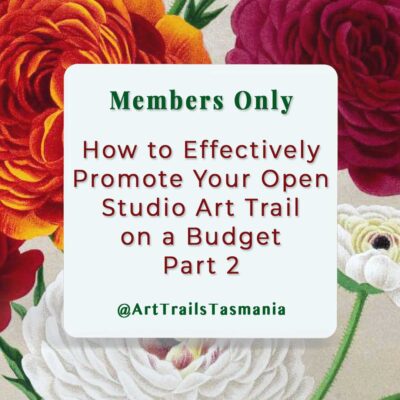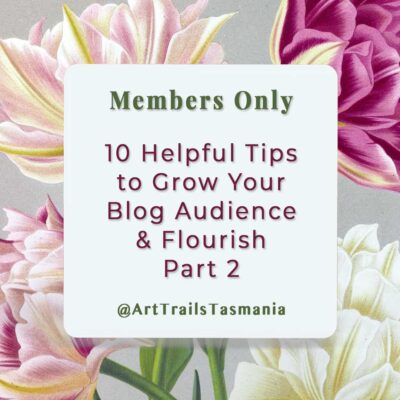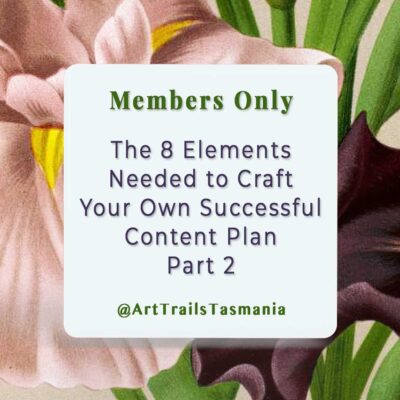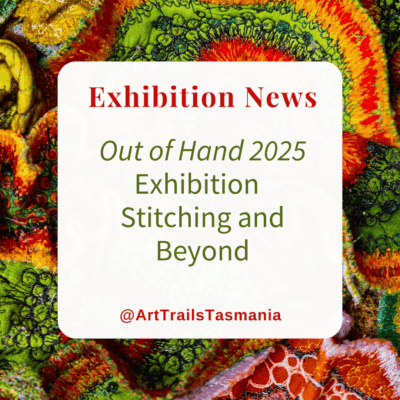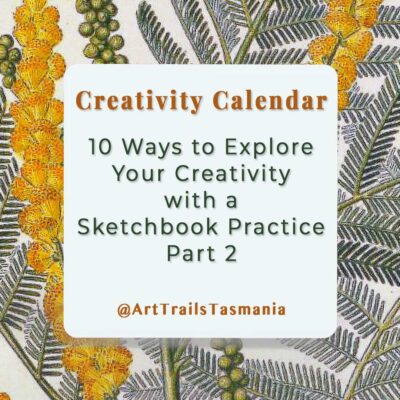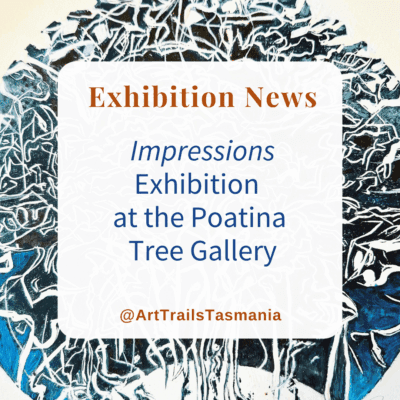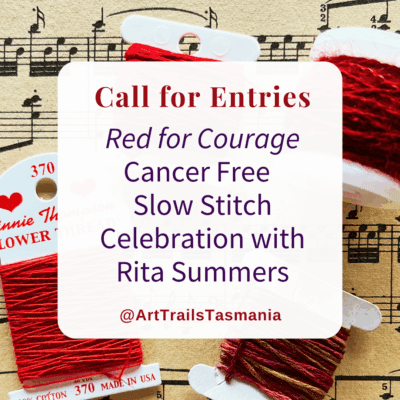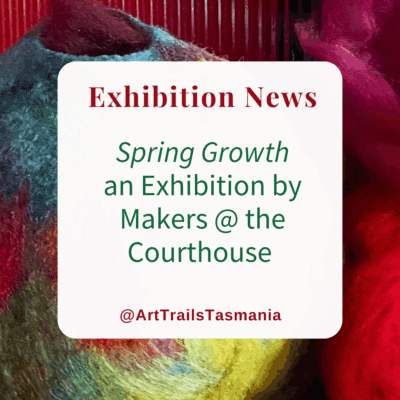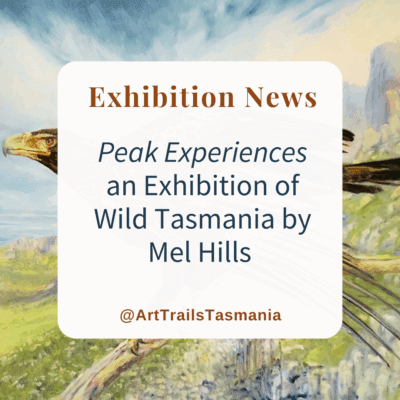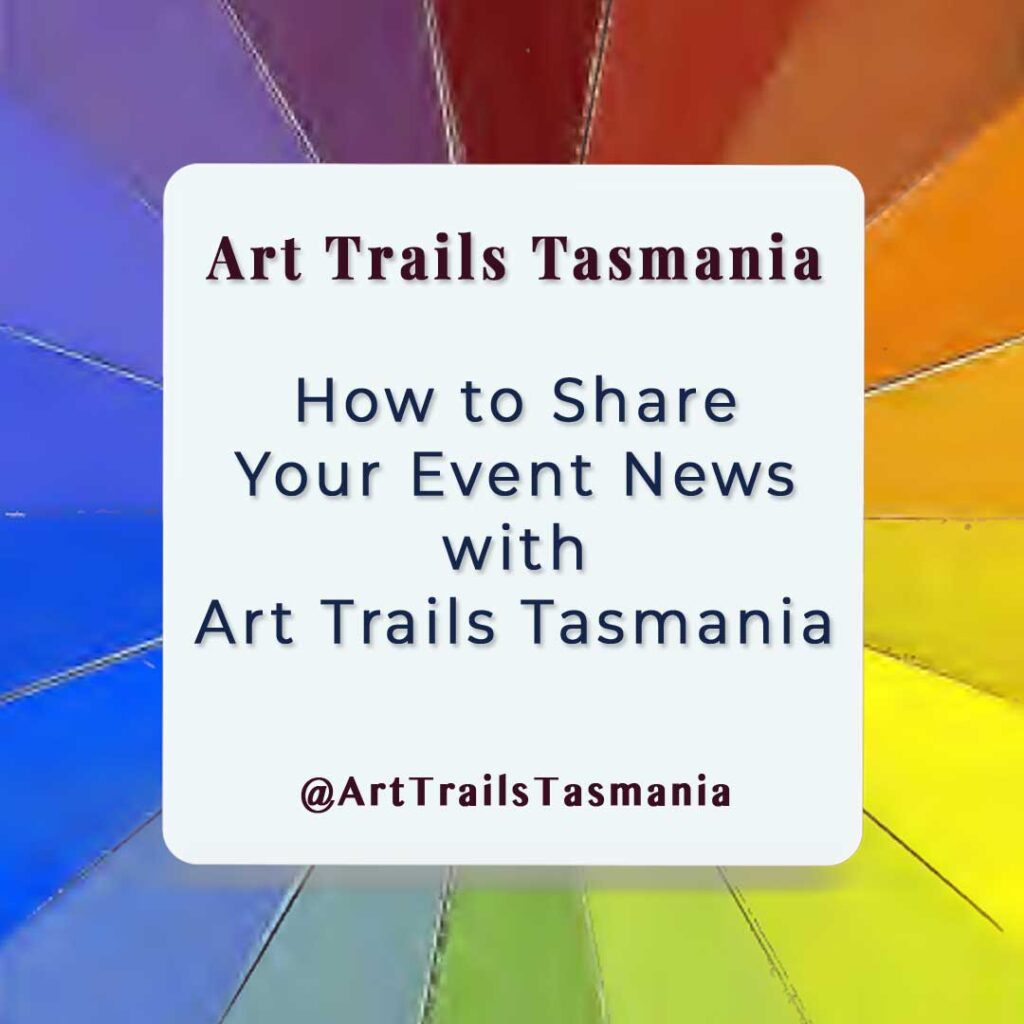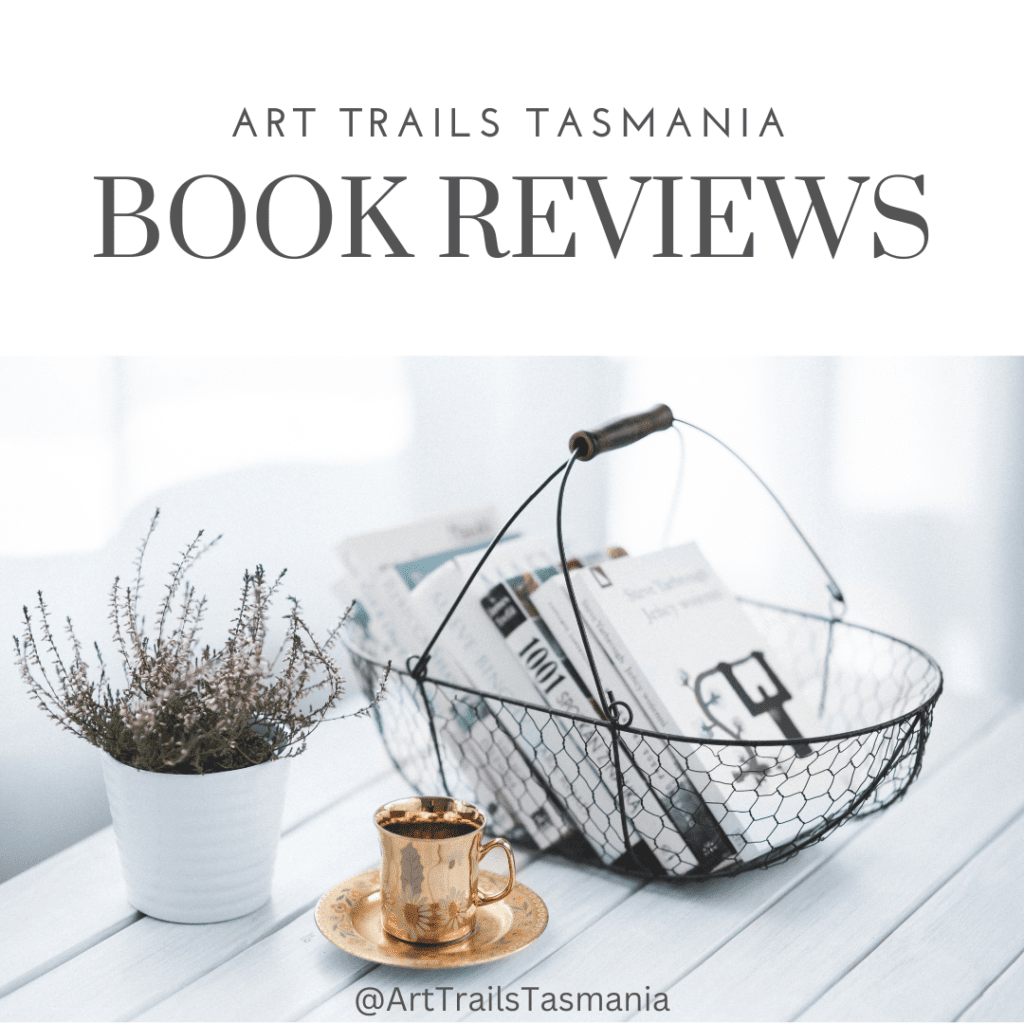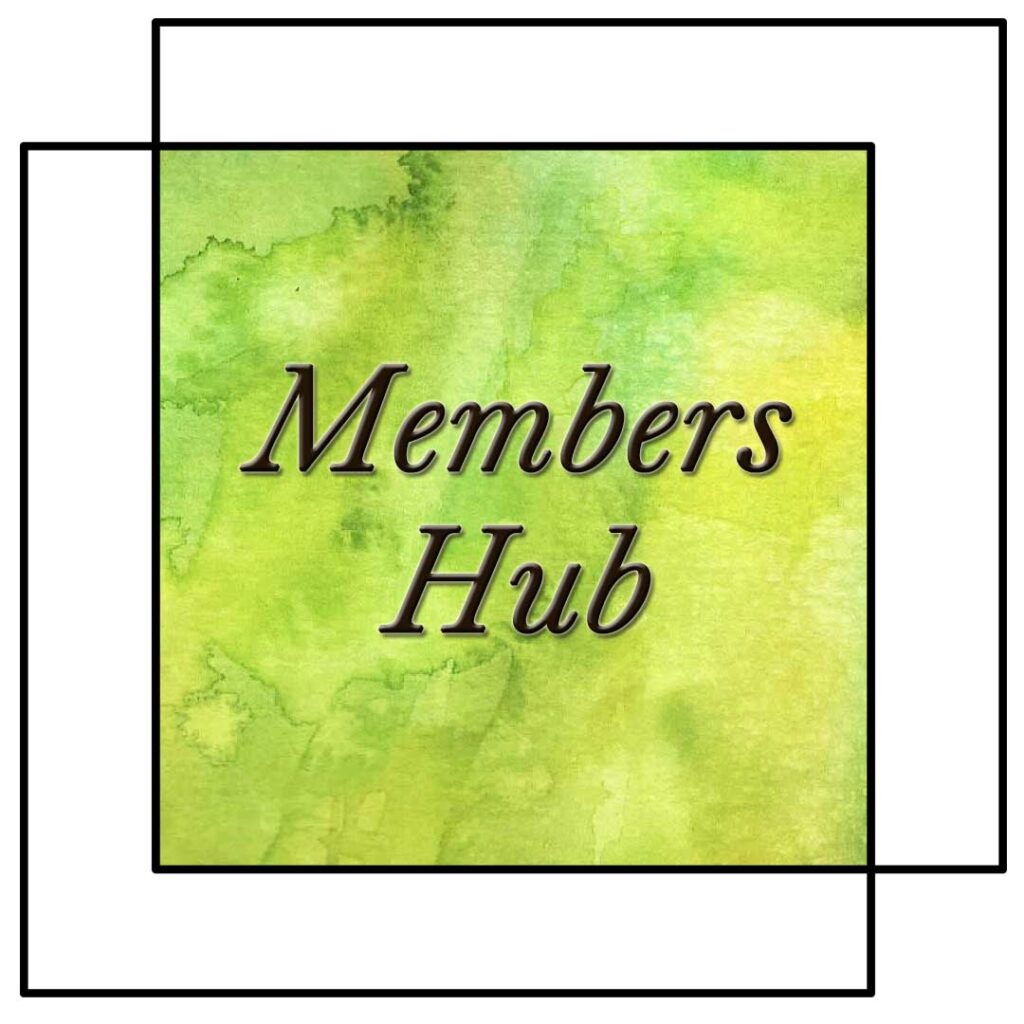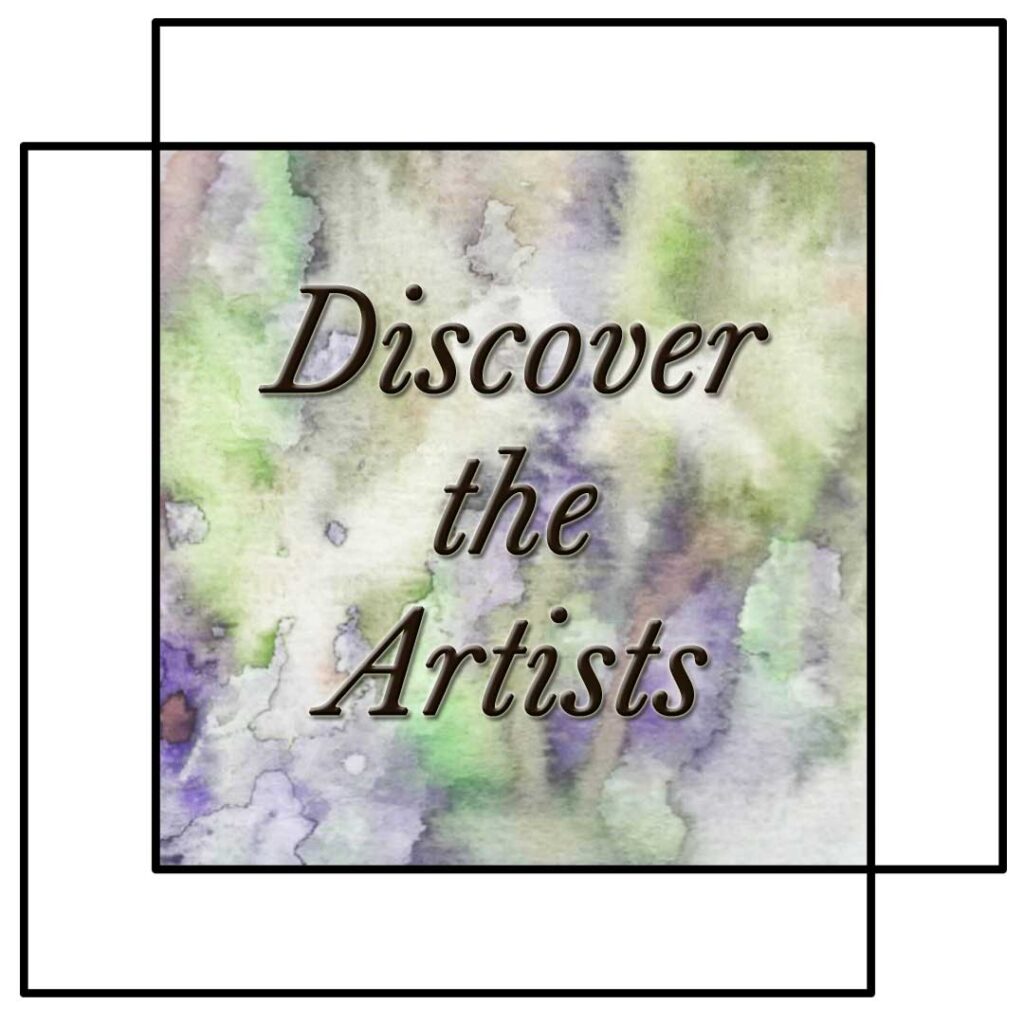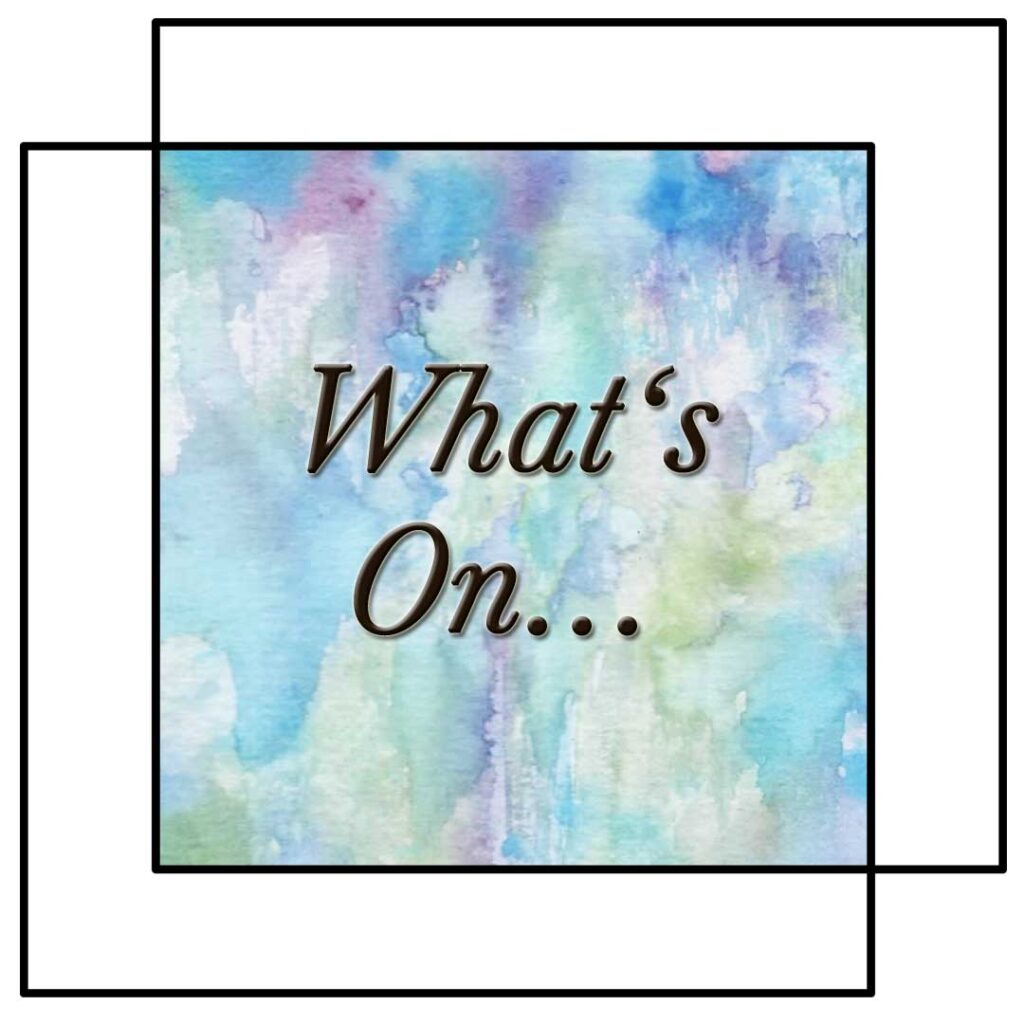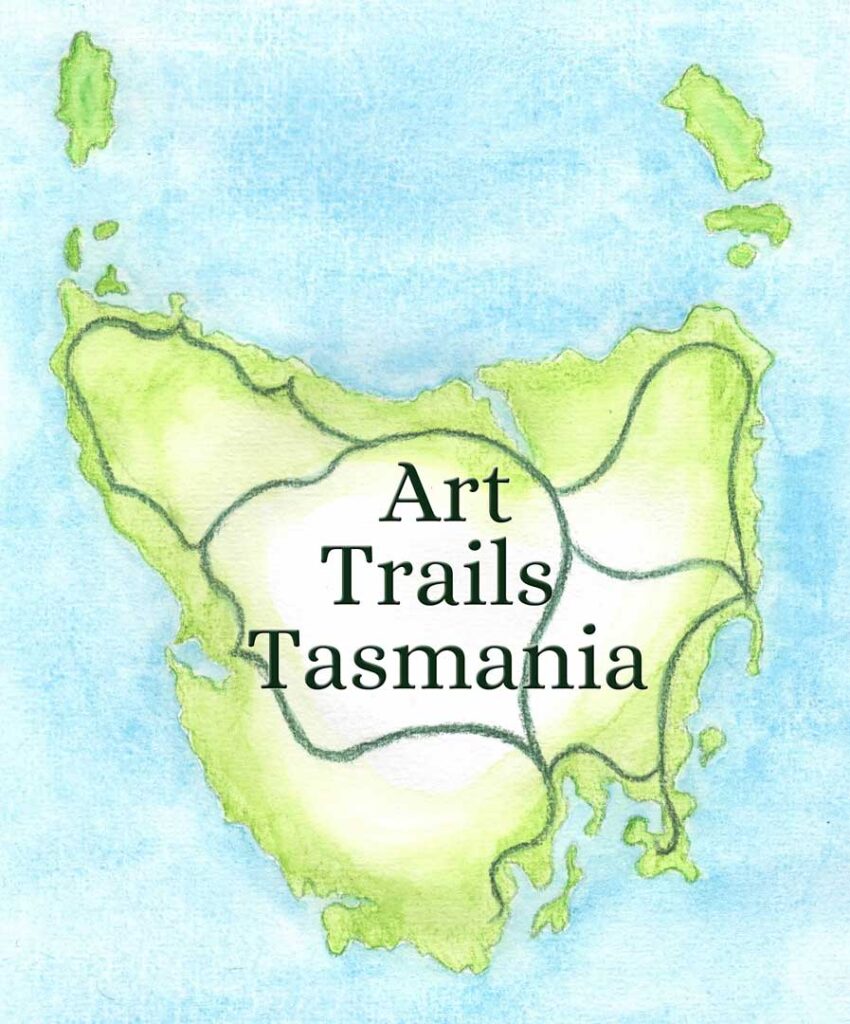Finding Joy in Restful Creativity
Creativity does not thrive on constant motion; it flourishes when given space to breathe. Rest is not absence, but a quiet resource that renews energy, focus, and imagination.
Where Part 1 explored how boredom, sleep, and daydreaming nurture the creative mind, this companion piece offers twelve practical rituals that turn rest into fertile ground for artistic growth.
These practices are intended to be lived slowly, integrated gently, and tailored to Tasmania’s landscapes — from the damp hush of rainforests to the bright clarity of coastal light.
Each ritual offers a way to pause with purpose: moments where the senses, body, and imagination find harmony. They encourage playfulness, creative mindfulness, and the joy of making without expectation.
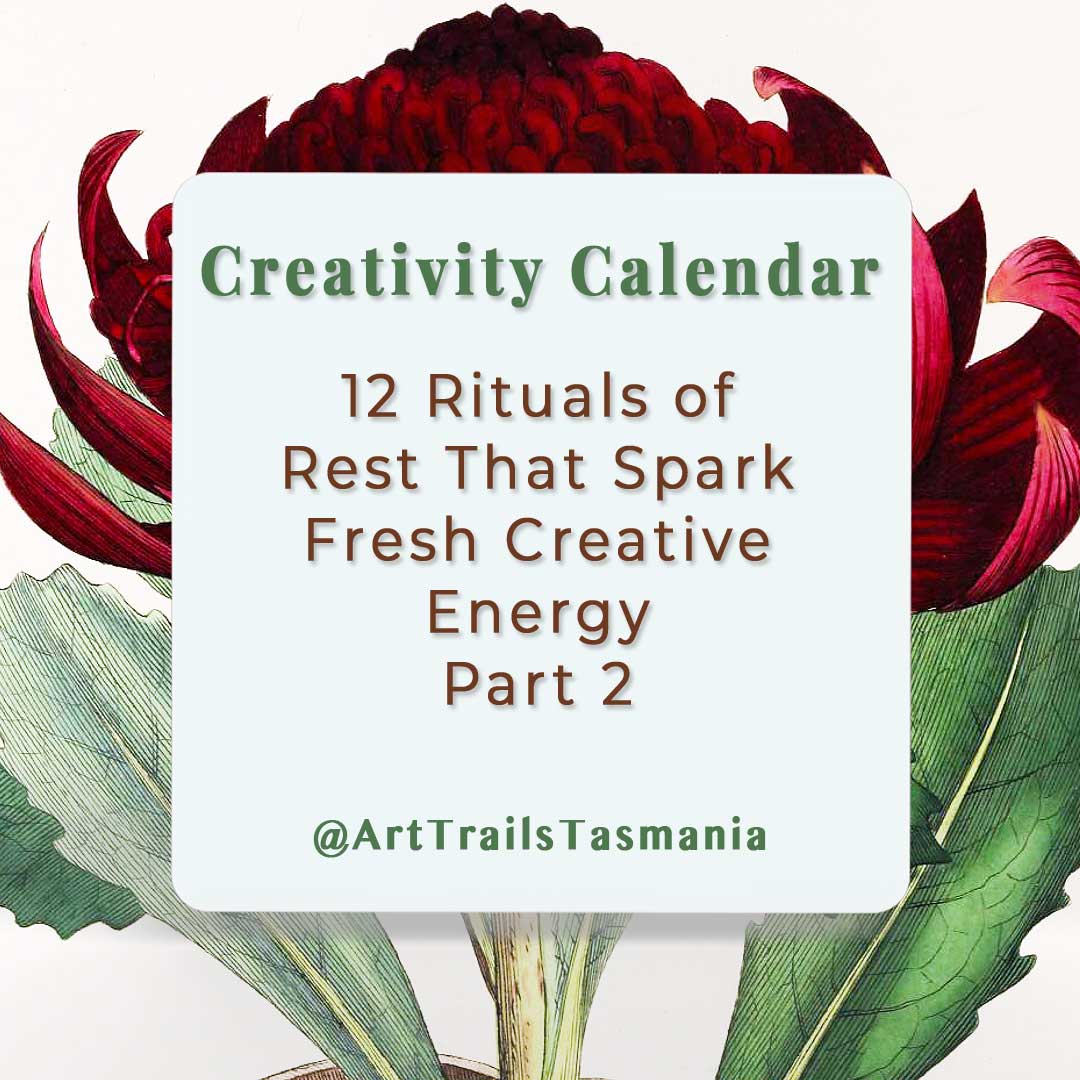
12 Practical Rituals to Explore Your Creativity
Here are 12 creative rituals for you to make your own:
1. Nature Journalling on Slow Walks
A slow walk becomes a moving meditation when combined with a sketchbook. Wander without hurry through a favourite patch of bush, a beach track, or a local garden.
Instead of counting steps or distance, attend to rhythm — the crunch of gravel, the rustle of leaves, the scent of blue gums.
Pause often to observe closely: a feather caught in grass, the spiral of a shell, a shadow pattern on bark.
Open the sketchbook and record what draws attention.
It might be a quick contour sketch, a splash of colour, or a few words describing texture or movement.
Allow imperfect marks; let curiosity lead. Nature journalling turns the outer landscape into a mirror for the inner one.
Over time, the pages fill with reminders of small wonders — a personal archive of sensory moments that quietly feed the creative spirit.
2. Blind Contour Sketching
Choose a small object — a seed pod, pebble, or flower — and place it before you.
Fix your eyes on the subject and, without looking at the page, let your pencil trace its outline in a single continuous motion.
Resist the urge to peek or correct. What emerges may look awkward, even comical, but that’s the beauty of the exercise.
Blind contour drawing teaches surrender and attentiveness. It shifts focus from results to the pure act of seeing.
This ritual dissolves stiffness in the creative hand and reminds artists that observation, not precision, is the heart of expression.
Repeating it regularly develops trust in the line itself — each curve and wobble becomes evidence of genuine looking.
Over time, this small act of discipline restores the beginner’s joy, where discovery outweighs outcome.
3. Five-Minute Creative Experiments
Creativity often thrives within small, well-defined limits. Set a timer for five minutes and give yourself a prompt such as “lines only”, “contrast”, or “movement”.
Choose any medium — pencil, collage scraps, ink, or watercolour — and start. The time pressure silences the inner critic and invites spontaneity. When the timer sounds, stop.
This ritual is a playground for the imagination.
Because the commitment is brief, experimentation feels safe; mistakes lose their weight.
Regular five-minute sessions keep creative muscles supple between larger projects.
Over weeks, these quick studies accumulate into an archive of textures, colours, and compositions that may later spark bigger ideas.
Above all, this simple ritual celebrates play — a reminder that joy and curiosity are the natural states of a healthy creative practice.
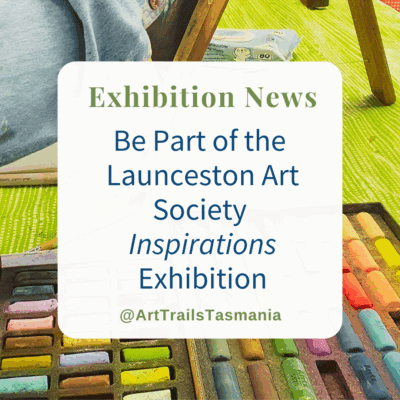
The Launceston Art Society Inspirations Exhibition
You’re invited to the Launceston Art Society “Inspirations” exhibition, a community art exhibition showcasing the diverse talents of local members.
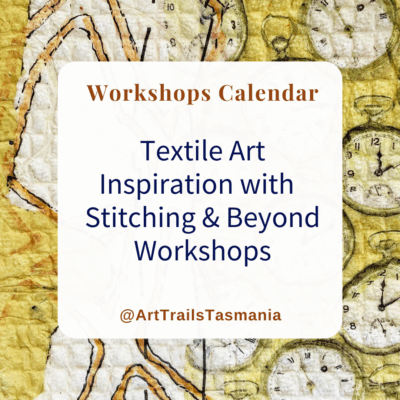
Textile Art Workshops with Stitching and Beyond
It’s time to be inspired by the latest calendar of workshops being brought to you by the friendly Stitching and Beyond group as they celebrate the textile arts!
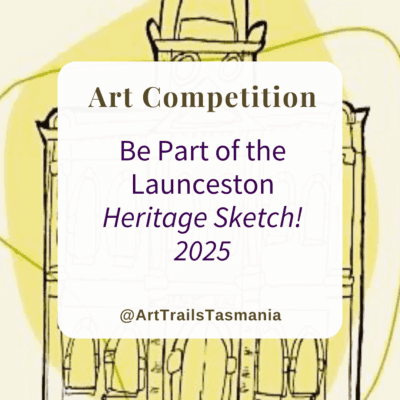
The Launceston Heritage Sketch 2025
This exciting Heritage Sketch Art Competition is for kids from Kinder to Year 12 and is all about exploring and drawing Launceston.
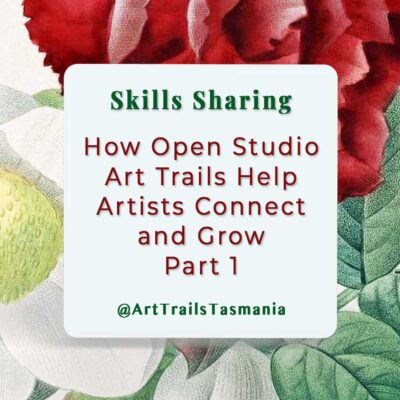
How Open Studio Art Trails Help Artists Connect and Grow Part 1
Find out how Open Studio Art Trails can help grow your profile as an artist, open doors to new opportunities and to thrive creatively.
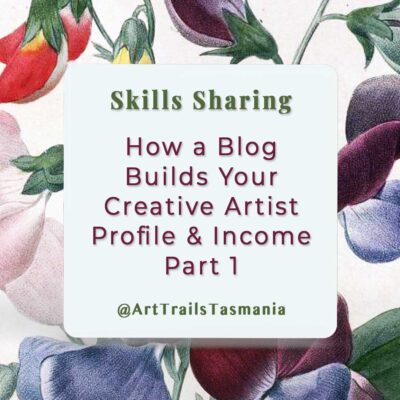
How a Blog Builds Your Creative Artist Profile and Income – Part 1
In part 1 in our series on how to make a blog grow your artist profile and income, we dive into what it is and how to get it working for you.
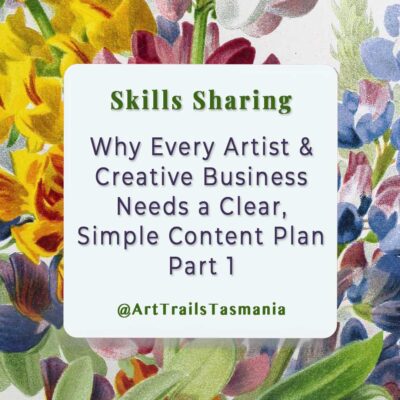
Why Every Artist and Creative Business Needs a Clear, Simple Content Plan – Part 1
In Part 1 in our series on Content Planning we explore why having a clear and simple content plan is so important for your growing creative business.
4. Creative Mindfulness: Listening with the Eyes
Find a still spot — perhaps a veranda, riverside, or shady tree.
Sit quietly and soften your gaze toward one area of the landscape. Rather than labelling what is seen, let the eyes rest as if listening.
Notice how light alters colours, how wind stirs patterns, how edges blur when attention relaxes.
This form of creative mindfulness teaches presence through looking. It anchors awareness in sensory experience rather than analysis.
Over time, such gentle attention seeps into drawing, writing, or crafting; perception becomes more nuanced, responses more intuitive.
Practised regularly, creative mindfulness it quietens mental chatter and restores focus. The world becomes richer, and in that richness, creativity reawakens — not forced, but invited.
5. Dream-Seed Journalling
Dreams are natural collaborations between imagination and rest. Keeping a notebook beside the bed allows fleeting images to be caught before they fade.
Upon waking, jot down fragments — colours, words, feelings, odd scenes. Resist editing or interpretation.
Over days and weeks, these scattered notes accumulate into a dream-seed journal: a collection of symbols that can later find form in sketches, stories, or designs.
Revisiting them offers surprising insights; recurring themes might whisper about new creative directions.
Even the act of recording deepens connection with intuition.
Dream-seed journalling reminds artists that rest continues to work quietly on their behalf, weaving unseen patterns that later blossom into tangible ideas.
6. The “No-Goal” Making Session
Allocate a stretch of uninterrupted time — perhaps an hour — to create without purpose.
Choose materials that feel inviting and begin without a plan. Follow impulse: make marks, tear paper, arrange objects, apply colour freely. The aim is to experience the process rather than produce an outcome.
In a world obsessed with results, the “no-goal” session feels liberating.
It dismantles pressure and rekindles curiosity. The mind rests because there’s nothing to achieve, and in that space, genuine exploration emerges.
Many artists rediscover playfulness through this approach — the kind that first sparked their love of making.
Some sessions yield accidental beauty; others end in mess. Both are equally valuable, for each session restores confidence in instinct and the joy of creation itself.
And it can be a surprisingly practical path towards revealing your own creative voice.
7. Micro-Rests in the Studio
Sustained focus can quietly drain energy, even when enthusiasm is high.
Introducing micro-rests within studio time preserves vitality.
Every 30–45 minutes, set tools down, close the eyes briefly, and take three deep breaths.
Look out a window, stretch hands, or step outside for a moment of sunlight.
These pauses recalibrate attention and prevent burnout.
They remind the body and mind that creativity benefits from rhythm — exertion balanced with ease.
Artists who incorporate micro-rests often notice more sustained flow and fewer mistakes.
Over time, the practice builds resilience; creativity becomes less a sprint, more a steady dance between action and recovery.
8. Seasonal Foraging and Material Play
Tasmania’s shifting seasons offer abundant materials for creative rest.
After rain, the ground gleams with leaves, twigs, and stones; in winter, the coast reveals shells and driftwood. Foraging is best done slowly and respectfully — take only what has already fallen.
Lay collected items on a workbench or windowsill. Let them remain there for days, perhaps weeks, without immediate use.
Observe how shapes and colours change as they dry or fade. Later, they might become printing plates, inspiration for textures, or the starting point for a sketch.
The act of gathering connects body and place, and the waiting period teaches patience. Creativity here grows from rhythm — a cycle of collecting, contemplating, and making.
9. Mapping the Creative Voice
A simple sketchbook exercise can clarify personal direction. Begin by choosing a word or emotion that resonates — “stillness”, “wild”, “renewal”.
Write it in the centre of a page. From that point, branch out with lines, shapes, or colours that echo the word. Add fragments of phrases, doodles, or associations that surface.
Over time, these maps form a visual diary of inner language. They reveal patterns — certain colours or symbols that repeat — offering clues about evolving themes.
This ritual encourages reflection without overthinking. It provides a restful way to engage creatively while stepping back from output.
Mapping the creative voice grounds practice in authenticity, showing that rest and reflection are integral to self-expression.
10. Visual Haiku Breaks
Keep a small poetry book or local art catalogue near the workspace. When energy dips, stop working and open it at random.
Read one short poem or study one artwork slowly, letting words or images sink in. Then, on a blank page, respond with three marks, three words, or a tiny sketch — your own “visual haiku”.
This ritual acts as a reset button for the mind.
The brevity of haiku encourages clarity, while the visual response reconnects feeling and form.
Practised regularly, it cultivates the ability to find depth in simplicity. It also bridges disciplines, allowing writing, art, and mindfulness to blend.
A single haiku break can shift mood, release tension, and restore creative rhythm within minutes.
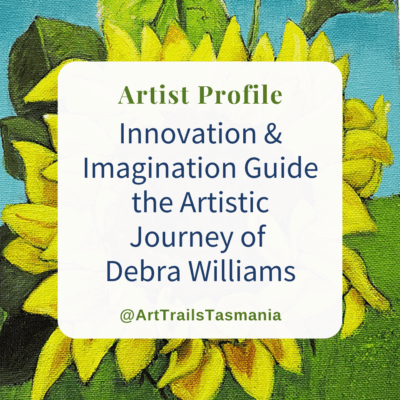
Innovation and Imagination Guide the Artistic Journey of Debra Williams
Be inspired by the artistic journey of Debra Williams as she challenges her own creative growth and finds joy through out.
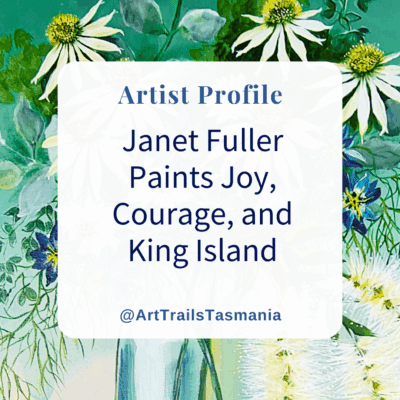
Janet Fuller Paints Joy, Courage & King Island
It’s time to meet King Island artist Janet Fuller and be inspired by her love for creativity, colour and being bold!
11. Seasonal Reflection and Sketch Exchange
At the end of each season, take an hour to revisit recent work — journal pages, sketches, photographs, or experiments.
Spread them out and look without judgement. Which ones still feel alive? Which carry quiet promise? Note these in a few lines on the back of the page or in a notebook.
If possible, exchange a few pieces with another maker — through the post, at a local market, or over tea.
Seeing one’s work through someone else’s eyes offers fresh insight. Reflection brings closure; sharing reawakens connection.
This gentle ritual of review and exchange ensures creative growth remains communal and cyclical, much like the seasons themselves.
12. Light Sketching at Dawn or Dusk
Dawn and dusk hold a softness that encourages contemplation.
Settle outdoors with a sketchbook or camera as the light shifts. Work quickly, responding to changing colours and forms. Allow imperfection; let the fading or emerging light decide when to stop.
These sessions nurture patience and humility. The transient light demands attentiveness but forbids overworking.
It invites surrender — a trust in fleeting beauty.
Repeated through the year, the practice documents the landscape’s moods and deepens connection with place.
For many, it becomes a daily meditation: a pause between sleep and activity, rest and creation, where the boundary between both gently dissolves.
This practice can be a lovely pathway to healing with creativity.
Rest as a Companion to Making
These twelve rituals transform rest into a creative ally. They work best when practiced lightly — woven into ordinary routines rather than scheduled as obligations.
Each one offers a different way to pause: through attention, touch, reflection, or play. Which ones are resonating with you? Are there variations on them that appeal?
For artists and makers, these practices align naturally with local landscapes and rhythms — sea air, shifting skies, and bush textures.
Rest becomes not a withdrawal but a listening, a moment where the mind slows enough to let imagination breathe.
When creativity is nourished by rest — by nature journalling, sketching, mindful seeing, and joyful experimentation — energy returns in fresh and surprising ways.
The voice of making grows clearer, the process becomes kinder, and the work itself begins to hum with renewed life.
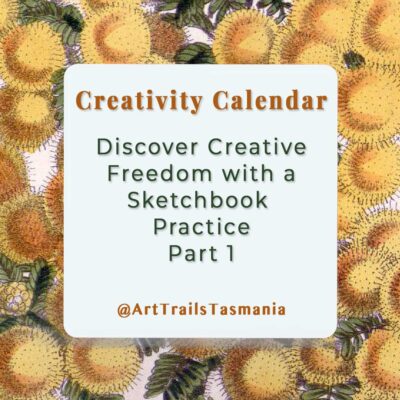
Discover Creative Freedom Through a Sketchbook Practice Part 1
Discover the joys of sketchbook practice in Part 1 of our series – explore materials, methods, and creative freedom for artists and crafters.
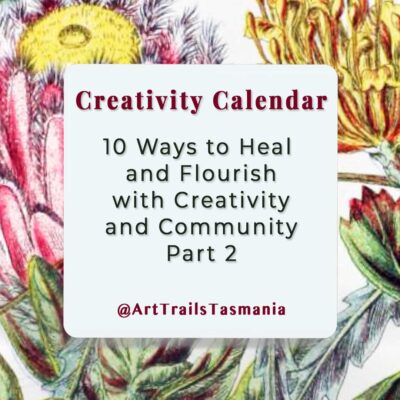
10 Ways to Heal and Flourish with Creativity and Community Part 2
In Part 2, Art Trails Tasmania founder, Belinda Stinson, explores 10 ways to heal with creativity and community as she navigates through a life changing period.
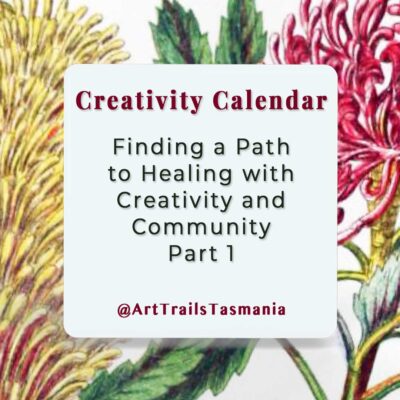
Finding a Path to Healing with Creativity and Community Part 1
In this deeply personal piece, Art Trails Tasmania founder, Belinda Stinson, shares how creativity & community is nurturing her through her journey with grief.
Read the Latest How To Blog Stories
How to Effectively Promote Your Open Studio Art Trail on a Budget Part 2
How to Effectively and Affordably Promote Your Open Studio Art Trail Open Studio Art Trail events offer incredible opportunities, but their success depends on how well they’re promoted. This is Part 2 in our series, focusing on affordable, effective ways to spread...
How Open Studio Art Trails Help Artists Connect and Grow Part 1
How Open Studio Art Trails Can Boost Your Creative Career Open Studio Art Trails invite the public into the heart of your creative world, offering an authentic glimpse behind the scenes. For artists and makers, they are a chance to connect directly with audiences,...
10 Helpful Tips to Grow Your Blog Audience and Flourish Part 2
Unlocking the Power of Your Blog Unlock the true potential of your creative journey with this blog, the exciting Part 2 in our series. Following on from How a Blog Builds Your Creative Artist Profile Part 1, this instalment offers fresh tips to sharpen your blogging...
How a Blog Builds Your Creative Artist Profile and Income – Part 1
How A Blog Can Make All the Difference A blog is a powerful tool for artists, makers, and groups looking to grow their creative profile and support income-generating activities. It helps promote exhibitions, sell work online, attract workshop bookings, and showcase...
8 Elements Needed For Your Successful Content Plan – Part 2
The 8 Essential Elements for Making a Successful Content Plan A content plan is your creative map for sharing your work with confidence, ease and clarity. This is Part 2 of our two-part series on creating a content plan for artists, makers, galleries, art groups and...
Why Every Artist and Creative Business Needs a Clear, Simple Content Plan – Part 1
How to Make Sense of Content Plans A content plan is the key to sharing your creative work and business with ease and confidence, across all your platforms and projects. This is Part 1 of a two-part series on content planning for artists, makers, galleries, event...
Read the Latest Blog Stories and Flourish…
Textile Art Workshops with Stitching and Beyond
Textile Art Workshops to Inspire Workshops are central to Stitching and Beyond’s creative programme, giving textile artists and makers the chance to explore new techniques and ideas. This latest calendar of workshops from October to January, highlights the richness of...
Janet Fuller Paints Joy, Courage & King Island
Inspiration is Everywhere on King Island I love it when things just work. That one amazing brushstroke that elevates the ordinary to something that makes you go "wow, that's it". When colours come together in a way that's so bold they explode off the canvas, or so...
The Launceston Heritage Sketch 2025
An Art Competition for All Kinder to Year 12 Launceston is a city steeped in history, nestled amidst breathtaking natural landscapes, and filled with vibrant neighbourhoods and cherished landmarks. This competition invites budding young creatives of all skill levels...
The Stitching and Beyond Out of Hand Exhibition
Be Inspired by the "Out of Hand" Exhibition by Stitching and Beyond Members This year marks the 20th anniversary of Stitching and Beyond, so to celebrate we are putting on our best Out of Hand exhibition EVER!! Enjoy a wonderful collection of fibre, paper and textile...
10 Ways to Explore Your Creativity with a Sketchbook Practice Part 2
10 Sketchbook Practice Ideas A sketchbook is more than just blank pages – it’s a space where curiosity, play, and experimentation come together. In Part One, we explored why sketchbooks are such a powerful tool for creative exploration. If you missed it, you can read...
Impressions Exhibition at the Poatina Tree Gallery
You're Invited to attend the Poatina Tree Gallery Impressions Exhibition Artists Justine Vaughan, Gaynor Peaty, Rosa MacManemy, Jacqueline Senior, Julie Irvin and Elizabeth Royce are the Newfields Printmakers and invite you to their "Impressions" exhibition. Based in...
Red for Courage Slow Stitch Celebration with Rita Summers
You're Invited to Be Part of Rita Summer's Cancer Free Celebration Help me celebrate being declared cancer-free after 5 years! Last month, I got the final all-clear. No more scans, no more specialist appointments. So now I want to celebrate! I would love it if you...
The Makers at the Courthouse Spring Growth Exhibition
Celebrate the Change of Seasons with the Spring Growth Exhibition We’re thrilled to announce our very first in-house art exhibition, “Spring Growth.” This special event will feature fresh, original works created exclusively by members of Makers at the Courthouse. The...
“Peak Experiences” an Exhibition Inspired by Wild Tasmania by Mel Hills
Explore the Mel Hills Exhibition "Peak Experiences" Step into a world of misty peaks, glinting waterfalls and alpine wildflowers as Mel Hills unveils her long-awaited mountain celebration series. Inspired by Tasmania’s iconic wilderness these breathtaking paintings...
Read What Our Members Say About Belonging
Join the growing, supportive artists community today and have your Artist story told here.
Belinda is doing a great job creating a professional looking artist hub online. Check out the profile I posted recently to see how well she does them. To all my artist friends let’s help make this THE go to place to discover local artists.
You won’t regret joining Art Trails Tasmania . It’s a welcoming community for creatives at any career stage.Becoming an Art Trails Tasmania member wasn’t a hard decision for me to make as it’s such a wealth of knowledge and support.Being member provides a quality way to showcase your creative endeavours and it’s quickly growing in reach.
We operate a home based picture framing business and recently joined Art Trails Tasmania as a means to giving us exposure to the wider artist community. We have almost immediately seen increase in activity thru our online sites, which I am certain will lead to more opportunities to grow our business.

